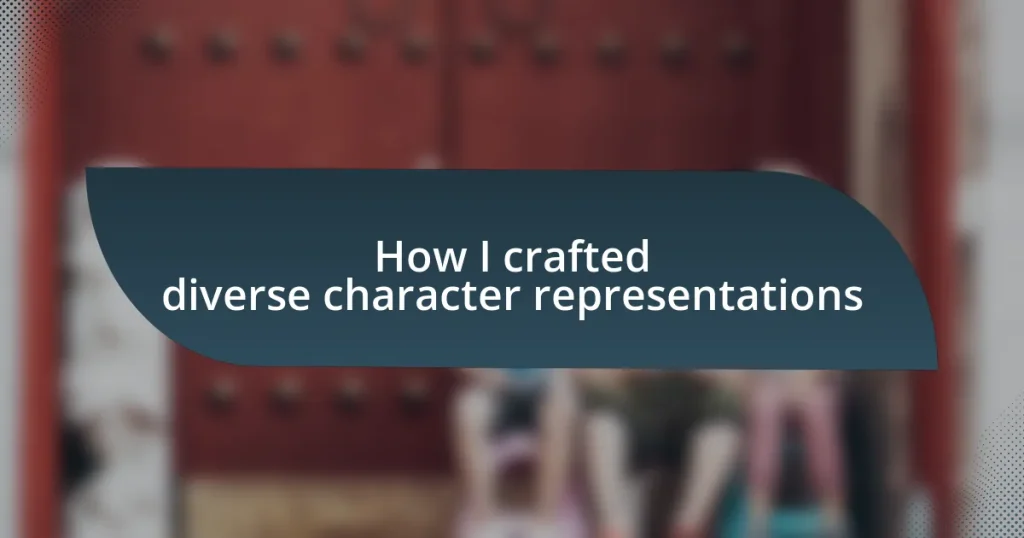Key takeaways:
- Diverse character representation enriches storytelling by challenging stereotypes and fostering empathy, allowing readers to connect with varied human experiences.
- Authenticity in character development is achieved through deep cultural research, personal experiences, and vulnerability, making characters relatable and multidimensional.
- Feedback plays a crucial role in character evolution, as it encourages deeper exploration and refinement, resulting in more authentic and resonant portrayals.
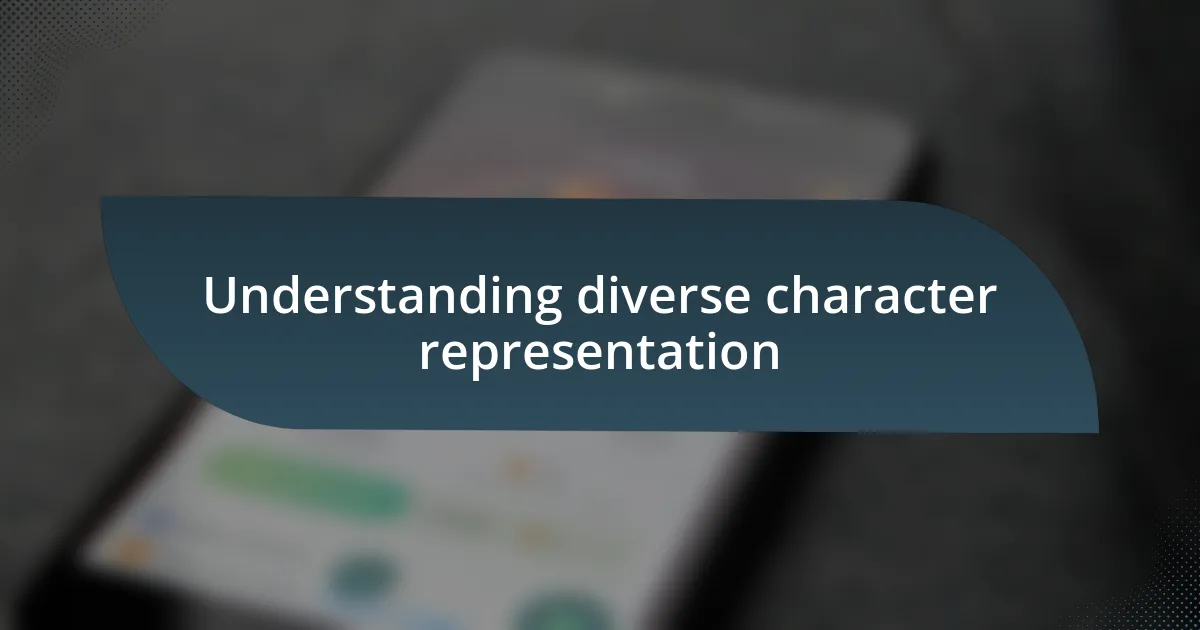
Understanding diverse character representation
Diverse character representation goes beyond just including different ethnicities or backgrounds; it encapsulates the complexities of human experience. I remember writing a character who navigated not only cultural identity but also personal trauma, and it was enlightening to see how readers connected with those layers. Isn’t it fascinating how a single narrative can resonate differently based on one’s own life experiences?
When I think about diverse representation, I often ponder how it challenges stereotypes and fosters empathy. For example, I crafted a character who was both a successful businesswoman and a devoted single parent, shattering preconceived notions I had about work-life balance. Have you ever encountered a character that reshaped your perspective on a familiar topic?
Creating these characters has taught me the value of authenticity in storytelling. Readers can sense when a character feels real, and they often tell me how these portrayals have inspired them to embrace their own identities. It raises a thought: how can we ensure that every voice, especially those less frequently heard, gets its moment to shine in our narratives?
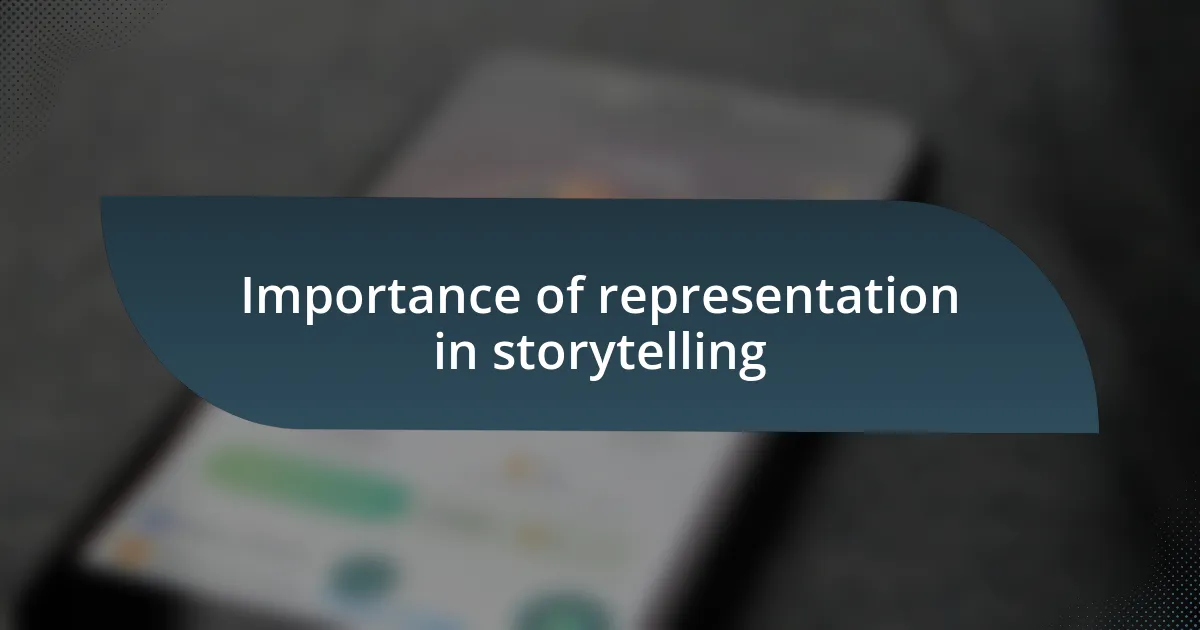
Importance of representation in storytelling
Representation in storytelling is vital because it offers a mirror for audiences to see themselves and an opportunity to understand lives vastly different from their own. When I wrote a character grappling with neurodiversity, I was reminded of a close friend who faced similar challenges. This narrative not only validated experiences but also sparked conversations around mental health in ways I hadn’t anticipated.
Consider these key aspects of representation:
- Building empathy: Stories featuring diverse characters allow readers to step into the shoes of others, cultivating understanding and compassion.
- Challenging stereotypes: Well-crafted diverse characters can dismantle harmful stereotypes, opening up discussions and redefining societal norms.
- Reflecting reality: Life is inherently diverse, and representation in storytelling aligns narratives with the complexities of the real world, making them more relatable.
- Encouraging belonging: When audiences see multifaceted characters like themselves, it fosters a sense of acceptance and community.
The impact of representation encompasses not just individual growth but also fosters a richer, more inclusive narrative landscape. Whether it’s through personal stories or cultural nuances, I find that every layer adds depth, inviting readers to explore the fullness of human experience.

Researching diverse cultural backgrounds
Researching diverse cultural backgrounds has been a transformative experience for me. I remember delving into the customs and traditions of Indigenous communities while crafting a character whose heritage was vastly different from my own. It felt like peeling back layers of history—each discovery not only influenced my character’s actions but also ignited a deeper respect for cultures I initially knew little about.
In my research, I’ve often relied on community voices. Speaking with individuals from various backgrounds adds a level of authenticity that books and articles sometimes miss. For example, when I consulted a friend from a Caribbean background, their vivid recounting of family celebrations inspired me to weave rich, sensory details into my narrative. It’s these personal exchanges that breathe life into characters and allow them to resonate emotionally with readers.
While conducting research, I also compare cultural beliefs and practices, which helps me avoid stereotypes and clichés. This analysis is crucial in creating nuanced portrayals that feel genuine and relatable. I’ve learned that enriching my understanding of diverse backgrounds not only enhances character depth but also elevates the overall storytelling experience.
| Cultural Background | Key Characteristics |
|---|---|
| Indigenous Communities | Strong spiritual connection to land and ancestors, rich oral traditions |
| Caribbean Culture | Vibrant music and dance, emphasis on family and community celebrations |
| Asian Cultures | Varied traditions, respect for elders, emphasis on education and family honor |
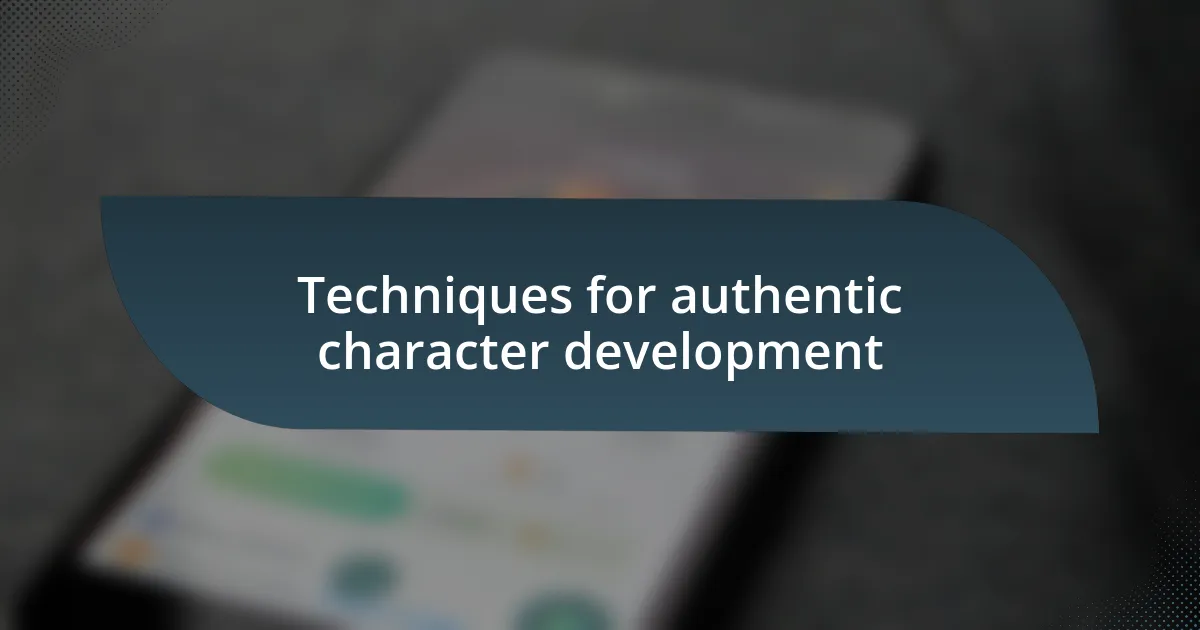
Techniques for authentic character development
Understanding character motivations is crucial for authentic development. I’ve found that mapping out a character’s background, dreams, and fears creates a vivid outline of who they are. For instance, while working on a character who immigrated to the U.S., I reflected deeply on the dreams and sacrifices that shape a person’s journey. Can you imagine leaving everything behind for a fresh start? This exercise helps ground the character in reality and makes their choices relatable.
Another technique I embrace is immersive role-playing. I try to step into my characters’ shoes, experiencing their emotions and challenges firsthand. Once, I spent a day engaging in activities tied to a character’s culture, like cooking traditional meals. The frustration I felt when the dish didn’t turn out right mirrored the character’s struggles and added layers to my writing. It’s a powerful reminder that authenticity often stems from lived experience, making every struggle relatable.
Vulnerability is also key in character development. I’ve learned the importance of allowing characters to show their imperfections and mistakes. A character who stumbles through a personal crisis often resonates more deeply with readers. They feel real, much like the people we encounter daily. When I developed a character grappling with guilt, I drew on my own experiences of feeling unworthy. How do we forgive ourselves when we fail? Exploring this in depth not only enhances character complexity but also connects the reader’s feelings to the narrative.
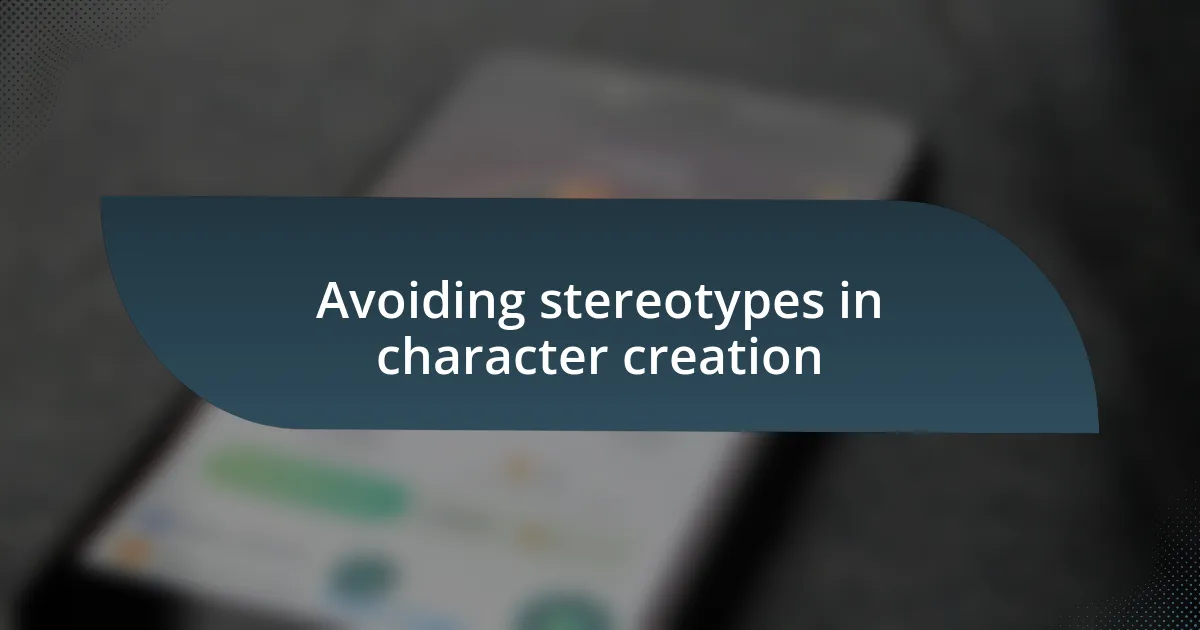
Avoiding stereotypes in character creation
When it comes to character creation, it’s essential to tread carefully around stereotypes. I’ve often found that a character who fits into a narrow mold can feel flat, lacking the depth necessary to resonate with readers. For instance, while crafting an Asian-American character, I chose to emphasize her individuality instead of relying on common tropes. I asked myself, “What unique experiences does she have that set her apart?” This approach not only enriches her persona but also fosters relatability.
Another strategy I apply is to focus on nuanced traits and motivations rather than defaulting to clichéd portrayals. During one project, I created a Black character who wasn’t defined by his race; instead, his interests in jazz music and engineering shaped his identity. By creating a well-rounded character, I aimed to reflect the diversity of real life, prompting readers to engage more deeply with his journey. Can you see how this shift can pull readers into a more authentic narrative?
It’s critical to surround ourselves with diverse influences when developing characters. I’ve often consulted with friends from various backgrounds to ensure my representation feels genuine and respectful. In one instance, a colleague shared insights about her cultural practices that I hadn’t considered before. This conversation opened my eyes to subtleties I could incorporate, ultimately creating a richer portrayal. How can we truly understand someone else’s experience without inviting their voices into our creative process?
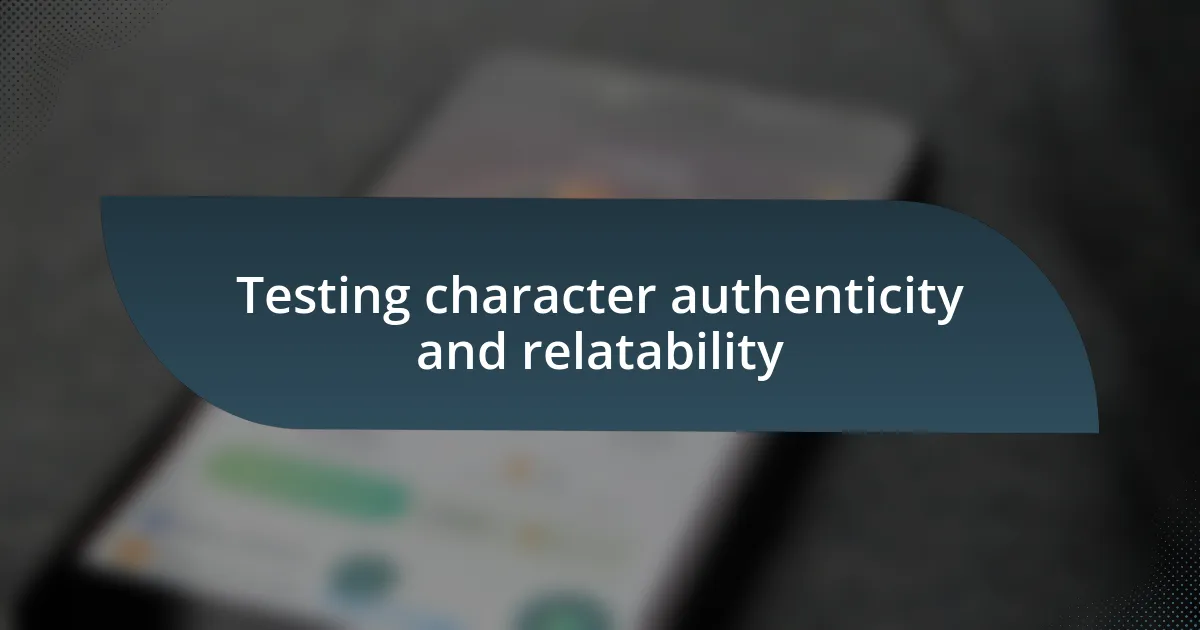
Testing character authenticity and relatability
To ensure authenticity and relatability, I often turn to the people in my life as sounding boards. For example, when writing a character who identifies as LGBTQ+, I reached out to friends within that community. Their personal stories highlighted struggles and triumphs I hadn’t considered, and those insights helped me craft a character whose journey felt genuinely resonant.
Another aspect I focus on is the character’s internal conflicts. I remember a time when I was developing a character navigating cultural expectations. By exploring her fears and aspirations, I shaped a persona that felt multidimensional. This depth allowed readers to connect with her struggles, prompting them to ask themselves, “Have I ever felt torn between what I want and what is expected of me?”
Testing character relatability also involves putting yourself in the character’s shoes. I often ask myself how I would react in similar situations. When I depicted a single mother facing financial hardship, I reflected on the challenges my own mother overcame. This kind of introspection not only adds layers to the character but also cultivates empathy, allowing readers to see pieces of themselves in the character’s experiences. How does this connection foster a deeper engagement with the story?

Evolving characters through continuous feedback
Feedback is an essential ingredient in evolving characters. I once shared a draft with a writing group and was surprised by their observations. One reader pointed out that a character I thought was strong came off as one-dimensional. This insight was a wake-up call; it prompted me to delve deeper into her backstory, ultimately breathing new life into her character arc.
Another key moment for me was when I received feedback on a character’s dialogue. A close friend remarked that the language I used felt dated and didn’t match the way young people communicate today. This prompted me to reconsider my character’s voice, and I began to incorporate real conversations I overheard at cafes or on social media. It was an eye-opening process that reinforced how vital fresh perspectives can be in shaping authentic representations.
Finally, I’ve found that evolving characters through continuous feedback often leads to unexpected connections. After revising a character based on reader input, someone reached out to tell me how much they related to her journey of self-discovery. This made me reflect: how many lives can our characters touch if we remain open to change? Engaging with feedback doesn’t just enhance authenticity; it creates a bridge between the character and the reader’s own life experiences.











